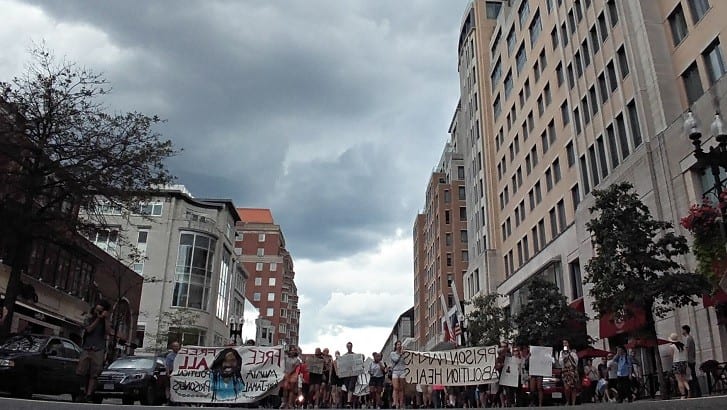
Two standout crime-and-punishment stories hit Hub headlines last week. Separately, they’re alarming. In tandem, the panoramic is even more frightening, a snapshot of the gap between the way that criminal justice reformers see things and the typical worldview of those who profit in or get a pass from the modern police state.
The first shocker, to quote the Boston Globe version, read, “Boston police are having trouble finding volunteers to wear body cameras for a pilot program” (it also ran a more direct header online, “City may have to force police to wear cameras”). This is the latest twist in the charade of cat and mouse that the Boston Police Department has played with watchdog groups pining for video accountability. While BPD officials have earned props from the commercial press for agreeing to test such devices, in reality the coming program is a gesture, and one that will barely resemble the parameters sought by the grassroots Boston Police Camera Action Team (BPCAT). For starters, BPCAT spokespeople are miffed that the body cam pilot will be on a volunteer basis and that cops will earn a stipend for participating.
Which brings us to the other headline of particular concern: “Boston police unions demand more guns, armor.” That’s right—the same authorities who are reluctant to have additional eyes watching them are also now requesting “long guns for patrol officers with ample ammunition,” ballistic shields and helmets, “more police officers,” and “extra loaded magazines.” Despite a popular movement for increased transparency including cameras, a letter from last month—which the Boston Police Patrolmen’s Association, the Boston Police Superior Officers Federation, and the Boston Police Detectives Benevolent Society reportedly sent to BPD Commissioner Bill Evans and Mayor Marty Walsh—also calls for “removing police officers’ names from city databases.” And continued:
We live in a world where a sitting President has basically ‘fanned the flames of Police hatred’ with political rhetoric and now a sitting Governor is politically afraid to speak … Police Officers and other public safety personnel are being murdered across this country at an alarming rate. Terrorist[s] are putting public employee information, garnered from municipal sources, on various web sites identifying public officials, Police Officers included; threatening their lives and the lives of their families alike.
Mayor Walsh feigned startled outrage over sections of the love note—he told the Globe, “I think there was some language in that letter that didn’t need to be used”—and said he doesn’t believe cops should carry long guns. Still, it’s only feasible that Walsh, a devoted son of Boston, knows all about the outfit that he’s dealing with. The mayor claims, “I’m not sure that letter reflects the overall feel of every officer,” but that’s the same excuse used whenever cops fart at the table. As I reported in the Boston Phoenix four years ago, when the patrolmen’s association last flashed its hideous ass: “The BPPA [publishes] a boldly bigoted official union newsletter, the Pax Centurion. Full of screeds against minorities, women, progressives, gays, Muslims, and even crime victims, its pages have long drawn ire from activists and [minority] union members alike.”
It’s a classic story that repeats itself. Officials in charge know that something stinks, and may even acknowledge the stench on a rare occasion, but are ultimately reluctant to facilitate deep change. This has been the case with BPD for years, if not always, and things aren’t likely to budge as long as major media outlets extend the pass—this week, for example, the New York Times published a puff piece on Commissioner Evans in which the BPD leader claimed that Black Lives Matter is “calling for the killing of police officers.” The commish must have skipped the BLM’s newly released Vision for Black Lives, which mentions nothing of the sort.
Not everyone was letting jailers off the hook this past week, though. With the American Correctional Association (ACA) in town at the Sheraton in Back Bay for its biannual Congress of Correction, prison abolitionists and other human rights crusaders crashed the party more than once. Starting with a dozen demonstrators disrupting the opening night gala, groups including the Young Abolitionists, Black and Pink, the City School, and Families for Justice as Healing delivered a message: The ACA, which runs a “standards and accreditation” department that contracts with prisons nationwide including here in Mass, provides “rubber stamps” for institutions with endemic “human rights abuses,” and is complicit in “prison profiteering.” As Mother Jones writer Shane Bauer reported in 2014, when he was singled out and tossed from an ACA conference in Utah:
[ACA] conventions offer a rare glimpse into the world of US prisons. Vendors in the exhibit hall openly discuss their increasing sales of SWAT-style equipment to prisons. Visitors can check out the new tech like drone-detection devices, surveillance systems, and shank-proof e-cigarettes. People hold workshops on issues like sex between prison guards and inmates and the problem of drug-dealing staff. Serious topics like suicide among transgender inmate populations are often revealingly discussed in terms of liability and cost.
 County and municipal leaders should know better than to welcome such unsavory company, but instead ignored all history and warning signs. As the Globe reported in 2001, in one instance the ACA received $10,000 to issue a cherry report of the Nashua Street Jail, only for seven officers from that institution—whose abuses somehow slid under the radar of the accrediting body—to be indicted on federal charges months later for beating inmates. Nevertheless, Suffolk County soon after hired the ACA to inspect its House of Correction and continues to do business with the company today, as does the Commonwealth.
County and municipal leaders should know better than to welcome such unsavory company, but instead ignored all history and warning signs. As the Globe reported in 2001, in one instance the ACA received $10,000 to issue a cherry report of the Nashua Street Jail, only for seven officers from that institution—whose abuses somehow slid under the radar of the accrediting body—to be indicted on federal charges months later for beating inmates. Nevertheless, Suffolk County soon after hired the ACA to inspect its House of Correction and continues to do business with the company today, as does the Commonwealth.
While ACA congress-goers took in workshops on topics like inmate radicalization, on Sunday more than 100 protesters marched west from Copley Square to call out attendees. Instead of taking Newbury Street, which was closed to cars for the afternoon, the group took the more difficult route against Boylston Street traffic, a crew of volunteers on bikes leading the pack to redirect vehicles. Once past the Prudential Center entrance, participants formed a circle at the intersection of Boylston and Gloucester Street and cranked the volume on their chants: “LIBERATE DON’T INCARCERATE / THE REAL TERRORIST IS THE POLICE STATE,” “EMPTY THE JAILS / REFORM ALWAYS FAILS.”
During the protest I met Beatrice Codianni, an advocate for inmates who herself was incarcerated in the Federal Correctional Institution and Camp at Danbury for 15 years through 2008. I had just heard a passing yuppie say to her friend, “Just because people they love are in jail doesn’t mean jail is a bad thing,” and asked Codianni how she’d explain the inadequacy of status quo American justice to somebody that ignorant.
 “I was in Danbury, which [the ACA] accredited even though they shouldn’t,” said Codianni, who complained to the association during her sentence but says she was ignored. “There were worms in the bathroom, for a time there was asbestos, there was fiberglass that fell from the ceiling, the medical and visiting rooms were not handicap accessible. They knew about it for years and never did anything about it.”
“I was in Danbury, which [the ACA] accredited even though they shouldn’t,” said Codianni, who complained to the association during her sentence but says she was ignored. “There were worms in the bathroom, for a time there was asbestos, there was fiberglass that fell from the ceiling, the medical and visiting rooms were not handicap accessible. They knew about it for years and never did anything about it.”
She continued: “The government should be ashamed of themselves for allowing this to go on. We need to get real, we need to tell the truth.”
A Queens, NY native who came to New England in 2004 to earn his MA in journalism at Boston University, Chris Faraone is the editor and co-publisher of DigBoston and a co-founder of the Boston Institute for Nonprofit Journalism. He has published several books including 99 Nights with the 99 Percent, and has written liner notes for hip-hop gods including Cypress Hill, Pete Rock, Nas, and various members of the Wu-Tang Clan.

